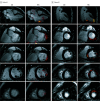Hybrid Positron Emission Tomography/Magnetic Resonance Imaging in Arrhythmic Mitral Valve Prolapse
- PMID: 32936270
- PMCID: PMC7254450
- DOI: 10.1001/jamacardio.2020.1555
Hybrid Positron Emission Tomography/Magnetic Resonance Imaging in Arrhythmic Mitral Valve Prolapse
Abstract
Importance: Myocardial replacement fibrosis has been reported to occur in one-third of patients with mitral valve prolapse (MVP) and significant mitral regurgitation (MR). However, it remains unknown whether there are detectable changes in myocardial metabolism suggestive of inflammation or ischemia that accompany the development of fibrosis.
Objectives: To characterize the burden and distribution of fluorine 18-labeled (18F) fluorodeoxyglucose (FDG) uptake and late gadolinium enhancement (LGE) in patients with degenerative MVP and ventricular ectopy.
Design, setting, and participants: Prospective observational study of 20 patients with MVP and significant primary degenerative MR who were referred for mitral valve repair and underwent hybrid positron emission tomography/magnetic resonance imaging (PET/MRI). Ventricular arrhythmias were categorized as either complex (n = 12) or minor (n = 8). Coregistered hybrid 18F FDG-PET and MRI LGE images were assessed and categorized. Recruitment occurred in the new patient clinic of a mitral valve repair reference center. This study was conducted from January 11, 2018, to June 26, 2019.
Exposures: Simultaneous cardiac 18F FDG-PET and MRI with LGE imaging on a hybrid PET/MRI system and ambulatory rhythm monitoring.
Main outcomes and measures: Patients were categorized by the presence and pattern of FDG uptake and LGE, the severity of ventricular arrhythmias, and the indication for mitral valve surgery.
Results: In the cohort of 20 patients, the median age was 59.5 years (interquartile range, 52.5-63.2 years). Focal, or focal-on-diffuse uptake, of 18F-FDG (PET positive) was detected in 17 of 20 patients (85%). The FDG uptake coexisted with areas of LGE (PET/MRI positive) in 14 patients (70%). Of the 5 asymptomatic patients with normal ventricular indices and absence of any surgical indications, all were PET/MRI positive.
Conclusions and relevance: In this pilot study, we demonstrate a novel association between degenerative MVP and FDG uptake, a surrogate for myocardial inflammation and/or ischemia. Such evidence of myocardial injury, even in asymptomatic patients, suggests an ongoing subclinical disease process. These findings warrant further investigation into whether imaging for myocardial inflammation, ischemia, and scar has a role in arrhythmic risk stratification and whether it provides incremental prognostic value in patients with chronic severe mitral regurgitation undergoing active surveillance.
Conflict of interest statement
Figures


Comment in
-
Mitral valve prolapse imaging: the role of tissue characterization.Quant Imaging Med Surg. 2020 Dec;10(12):2396-2400. doi: 10.21037/qims-2020-25. Quant Imaging Med Surg. 2020. PMID: 33269239 Free PMC article. No abstract available.
References
-
- Tung R, Bauer B, Schelbert H, et al. . Incidence of abnormal positron emission tomography in patients with unexplained cardiomyopathy and ventricular arrhythmias: the potential role of occult inflammation in arrhythmogenesis. Heart Rhythm. 2015;12(12):2488-2498. doi:10.1016/j.hrthm.2015.08.014 - DOI - PMC - PubMed
Publication types
MeSH terms
Substances
Grants and funding
LinkOut - more resources
Full Text Sources
Medical
Miscellaneous

